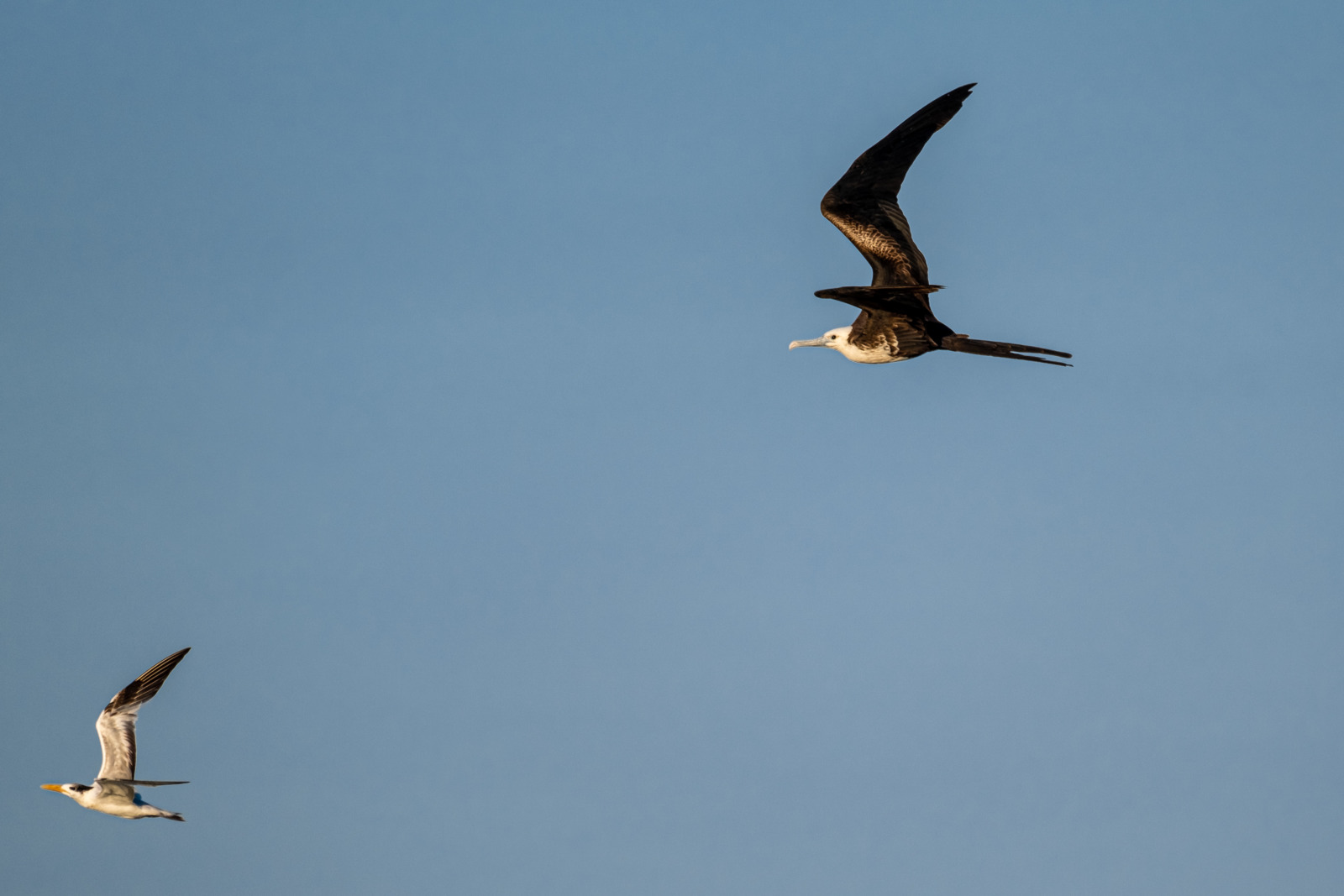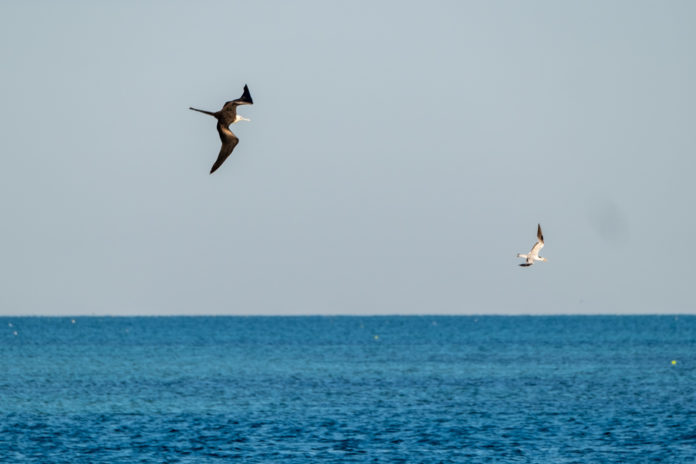It seemed like a squabble between royal terns at first – two seemingly identical birds, white with orange grove orange bills, way high up, circling around, one chasing the other, then the other chasing the one. But it also seemed a little flirty, like an improvised dance, a little unsure, a little awkward, maybe the first stages of trust. There was also a lot of yelling, him shrieking skirrup and her screaming, kleep kleep over and over again. (Unless it was the other way around.)
Thinking about it, royal terns are generally peaceable creatures, unless you’re a small fish. They don’t go in for the aggressive, for the agonistic. So I started to suspect all the skirrups and kleep kleeps translated roughly to a series of Hey, ladies and Hey, sailors. Which tuned out to be true.
Things finally clicked between them. All the loose choreography hit a groove, and they fell into this long, perfect, synchronous, descending spiral – their bodies only inches away – as if they were trying to draw Frank Lloyd Wright’s floor plan for the Guggenheim museum in the sky. Just before they hit the water they pulled up, and without so much as a curtsy, went their separate ways. Maybe it was the start of something – royal terns are seasonally monogamous and will sometimes start the mating process while they are outside of their breeding territory. (They breed in Florida, but not the Keys.) Maybe it was just a little vacation fling before they head back to find their Mr./Ms. Right – or Mr./Ms. Right for the season, anyway. A courtship flight doesn’t have to be a commitment.
It was a spectacular thing to see, but I hadn’t come down to the dock for a love story. I’d come for the piracy, the harassment, the theft and the abuse. Which sounds judgmental, so maybe it’s better to couch it in more scientific terms: I’d come to see kleptoparasitism in action.
Kleptoparasitism is basically one creature stealing another creature’s food. It’s bullies stealing someone’s lunch instead of their lunch money, but as an evolved feeding strategy.
You see it in the Keys sometimes when brown pelicans dive into the ocean, fill their pouches full of water and fish, and then slowly try to drain the water without losing any fish. Since the pelicans are somewhat immobilized in this process, laughing gulls will come in, land on their head, and try to jab their bills into the pelican’s mouth to steal the fish.
What I’d come to see in this instance was the latest episode of the eternal contest between royal terns and magnificent frigatebirds. It’s generally an unpredictable event, and usually it happens out on the open ocean.
The magnificent frigatebird’s three chief weapons are fear, surprise, ruthless efficiency and an almost fanatical devotion to the laws of aeronautics.
I’d caught a preview of it from far away the evening before. There were slightly fewer than 200 royal terns spread out across the railing of a very long dock, all facing into the wind. A frigatebird had come in slow, making herself known at the last moment, then dropping lower and lower. Some of the terns squawked, some crouched down, but a dozen or so took off in panic, and the frigatebird followed them loosely until she could cut one loose from the flock, and then she chased it back and forth across the water for a long time, ultimately giving up, unless she made another run after I was gone.
All of which got me wondering how habitual frigatebirds were. During daylight hours there was always a significant number of terns hanging out on that railing. Which seemed like easy picking for an air pirate. Why not come back every night for a regular snack?
The stealing another bird’s food thing isn’t as gross as it sounds. Terns, like most birds, don’t chew their food. They swallow it whole. But it doesn’t go directly to their stomach. It goes to their crop, a kind of pre-digestive antechamber to the digestive track. So the fish a frigatebird is trying to get regurgitated is usually recently caught and still whole.
Frigatebirds spend their lives at sea, but they can’t get wet. Their feathers lack the oils to repel water, so if they hit the water, they generally don’t come back up. Which means they either have to snag fish from the top few inches of the ocean with their bills, dangling their head down like a skyhook. Or they have to steal other birds’ food.
After the whole romantic prelude, it only took about five minutes for a frigatebird to slide into the airspace above and loom. It actually wasn’t the same bird from the evening before, it was a juvenile. (Adult male magnificent frigatebirds have all black feathers, adult females have a white breast, and juveniles have a white head and breast.)

I expected it to drop down and try to scare up some birds off the railing, but instead he caught sight of a royal out by itself over the water, trying to return to the railing and the comfort of the flock. But the chase was on.
A royal tern is smaller than a magnificent frigatebird, with less than half the wingspan and less than a third of the weight, making them more agile, but frigatebirds know how to work it.
The tern threw a long series of jukes and turns, speeding up, slowing down, flying sideways, banking hard, doubling back, then going all out again. But the frigatebird managed to simultaneously keep the pressure on and hang back far enough to anticipate the tern’s moves.
They would go at it intensely for 30 or 40 seconds, then there would be a pause in the action while they both gathered themselves and caught their breath. Then the frigatebird would turn the pressure on again. More jukes, feints, banks and lunges. They would climb several hundred feet, then dive down toward the hard deck of the ocean. It was amazing how well the frigatebird could anticipate, but possibly that is the difference between chasing and being chased.
Eventually, though, the royal tern did it – opened its bill and puked out the fish. It fell a distance, then splashed onto the surface of the water. The frigatebird changed direction with an unhurried nonchalance, plucking it from the waves like a coin from the sidewalk.
After a few flaps to regain altitude, it took off toward the open water, no doubt seeking other bounty.



























